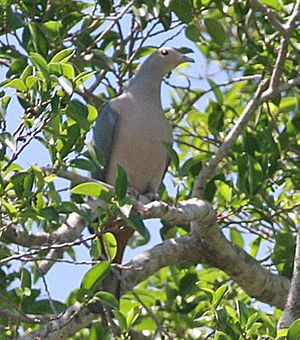Pink-headed fruit pigeon
| Pink-headed fruit pigeon | ||||||||||
|---|---|---|---|---|---|---|---|---|---|---|

Pink-headed fruit pigeon in West Timor |
||||||||||
| Systematics | ||||||||||
|
||||||||||
| Scientific name | ||||||||||
| Ducula rosacea | ||||||||||
| ( Temminck , 1835) |
The pink-headed imperial pigeon ( Ducula rosacea ), and island fruit dove called, is a Southeast Asian representatives of the bird species of large fruit pigeons (Meliphagidae). It is a medium-sized species of fruit pigeon with a body shape typical of large fruit pigeons, which occurs mainly on small islands and the coastal regions of larger islands.
Your inventory situation is by the IUCN endangered with potentially ( near threatened ) specified.
Appearance
anatomy
The males of the pink-headed fruit pigeon reach a body length between 41 and 43.5 centimeters, the females remain somewhat smaller with 39 to 41 centimeters. The tail accounts for 12.6 to 14.7 centimeters of the body length. The wing length is 220 to 245 millimeters in the males, 212 to 242 millimeters in the females. The beak is 17 to 20 millimeters long. The weight is between 360 and 413 grams. Apart from the difference in size, there is no noticeable gender dimorphism .
Adult pink-headed fruit pigeons
The wax skin is only pinnate at the base, the feathers surrounding the base of the beak are creamy white. The forehead, the reins, the crown and the neck are wine-pink, only the feathers around the eyes are cream-colored. The neck is slate gray and then merges into a darker, glossy gray-green coat. The wing covers are also glossy gray-green. The rest of the upper plumage is also gray-green, but it lacks the metallic sheen.
The chin is cream-colored, the chest and the pelvis are dark wine-pink and then merge into a grayer tone on the flanks, thighs and feathered legs. The under tail-coverts are dark red-brown. The iris is dark red-brown, in some individuals also orange. The very narrow orbital ring is purple. The beak is slate gray with a reddish base and a reddish wax skin. The legs and feet are reddish-purple.
Fledglings
Young birds are similar to the adult birds, but with them the vertex is grayer and does not contrast with the back of the neck. The elytra are more matt and brownish. The greenish shimmer of the upper plumage is still missing.
Possible confusion
There are several other pigeon species in the distribution area of the Rosakopf fruit pigeon, with which it can be confused.
The bronze fruit pigeon is larger and has a monochrome gray head and neck, which contrasts strongly with the otherwise shiny green upper plumage. The slate-back fruit pigeon occurs like the pink-headed fruit pigeon in Timor and weather. It is a mountain-dwelling species with a gray crown and gray ear-covers that stand out against the wine-red breast. The under tail-coverts are pale cinnamon and not darker than the belly. The beak is black, the legs are black-purple. The black-backed fruit pigeon is also a type of mountain forest. It has a gray parting, which stands out strongly with the wine-red ear covers and the wine-red neck. The under tail coverts are the same color as the belly. The tail plumage has a pale gray end band. The white-eyed fruit pigeon is significantly larger and has an ash-gray crown and ash-gray ear-covers, the upper side of the body is metallic blue-green and the under-tail-covers are gray.
Occurrence and habitat
The species is found on most of the Lesser Sunda Islands , the Southern Moluccas, and a few other small islands in the Malay Archipelago . The westernmost point of the distribution is the Karimunjawa Islands , north of Java . The southernmost point is the island of Timor , the easternmost the Kei Islands and the northernmost the island Bacan , the only one of the northern Moluccas . On Wetar , the pink-headed fruit pigeon is the most common pigeon on the island. The species is also common on Jampea , Timor and the Tanimbar Islands . The fruit pigeon is not common on Atauro , but it is widespread in wooded areas at altitudes above 250 m. The relatively large pigeon is repeatedly a victim of hunters, which is why it is considered to be potentially endangered, even if the hunting pressure is not present in the entire distribution area.
The pink-headed fruit pigeon is a resident bird . It lives in forests, bushland, mangroves and fields up to an altitude of 1100 m .
Way of life
The pink-headed fruit pigeon lives solitary or in pairs. Only in fruit-bearing trees can groups of up to six individuals gather. She lives exclusively on fruits.
The reproductive biology of this species has not yet been studied.
literature
- David Gibbs, Eustace Barnes and John Cox: Pigeons and Doves - A Guide to the Pigeons and Doves of the World. Pica Press, Sussex 2001, ISBN 90-74345-26-3 .
- Gerhard Rösler: The wild pigeons of the earth - free living, keeping and breeding. M. & H. Schaper Verlag, Alfeld-Hannover 1996, ISBN 3-7944-0184-0 .
Web links
- Videos, photos and sound recordings about Ducula rosacea in the Internet Bird Collection
- Ducula rosacea onthe IUCN Red List of Threatened Species .
- Call of the Rosakopf fruit pigeon on AVoCet
Individual evidence
- ^ Gibbs, Barnes and Cox: Pigeons and Doves , p. 548.
- ↑ Handbook of the Birds of the World on the Rosakopf Fruchttaube , accessed on May 23, 2017.
- ↑ a b c Gibbs, Barnes and Cox: Pigeons and Doves , p. 549.
- ^ Bird Life International: Pink-headed Imperial-pigeon Ducula rosacea , accessed March 2, 2013
- ^ Colin R. Trainor and Thomas Soares: Birds of Atauro Island, Timor-Leste (East Timor) , Forktail 20 (2004), pp. 41-48
- ^ Bird Life International: Pink-headed Imperial-pigeon Ducula rosacea, Additional Information on this species , accessed February 20, 2013